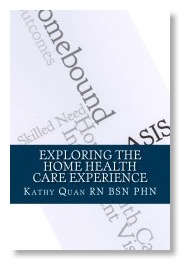The Homebound Status
©2020 HomeHealth101.com ALL Rights Reserved
Perhaps one of the more difficult qualifications for skilled home health care is homebound status. In order for a patient to receive home care benefits under Medicare, Medicaid if over 21 years of age, (note: Medicaid regulations regarding homebound status can vary from state to state... please check your local regs.) and most private insurance policies, by law, the agency and the physician must certify that the patient is homebound.
The justification for this is that if a patient is NOT homebound, they can obtain the medical care, treatment and teaching at a clinic, MD office, or other outpatient setting. Therefore, reimbursement is dependent upon documentation to support the certification of the homebound status throughout the plan of care.
The homebound status is not necessarily permanent, however, it must be in effect at all times when skilled home health care is being provided.
Some private insurance companies (and Medicaid in some states) will pay for home care even if the patient is not homebound. Additionally, in rare instances, the care can even be provided at the patient’s place of business. The key issue here is that your agency’s admission policy must allow for these exceptions to be in compliance for the scrutiny of a surveyor.
Homebound does not mean the patient must be confined to bed or a wheelchair, or even to his house, but rather, that the patient either requires assistance (human and/ or a device) to leave his home, or leaving poses a taxing effort to the patient. The "taxing effort" must be defined in your documentation and individualized to that patient.
Just because a patient does not have a car, does not make him homebound. If however, he cannot walk the 2 blocks to the bus stop, examine the reasons why and perhaps a homebound status can be found and documented.
Look for the reasons he no longer drives as a clue to his homebound status. This won't always solve the mystery, but it's a good place to start. For example he may have short term memory problems, a balance or gait disturbance, a seizure disorder, frequent TIAs or a history of CVAs with little visible residual. Therefore, some of these factors may help to define his homebound status.
The justification for this is that if a patient is NOT homebound, they can obtain the medical care, treatment and teaching at a clinic, MD office, or other outpatient setting. Therefore, reimbursement is dependent upon documentation to support the certification of the homebound status throughout the plan of care.
The homebound status is not necessarily permanent, however, it must be in effect at all times when skilled home health care is being provided.
Some private insurance companies (and Medicaid in some states) will pay for home care even if the patient is not homebound. Additionally, in rare instances, the care can even be provided at the patient’s place of business. The key issue here is that your agency’s admission policy must allow for these exceptions to be in compliance for the scrutiny of a surveyor.
Homebound does not mean the patient must be confined to bed or a wheelchair, or even to his house, but rather, that the patient either requires assistance (human and/ or a device) to leave his home, or leaving poses a taxing effort to the patient. The "taxing effort" must be defined in your documentation and individualized to that patient.
Lack of transportation, for example, does NOT fulfill a homebound qualification. The mere fact that the patient and/or spouse no longer drives, or is not able to drive currently, does not make him homebound.
Just because a patient does not have a car, does not make him homebound. If however, he cannot walk the 2 blocks to the bus stop, examine the reasons why and perhaps a homebound status can be found and documented.
Look for the reasons he no longer drives as a clue to his homebound status. This won't always solve the mystery, but it's a good place to start. For example he may have short term memory problems, a balance or gait disturbance, a seizure disorder, frequent TIAs or a history of CVAs with little visible residual. Therefore, some of these factors may help to define his homebound status.
Homebound status is not always permanent. A patient recovering from surgery, an accident, or episode of acute illness can be homebound for a short term. However, once that status changes, the patient must be discharged for outpatient care or follow up.
By the same token, homebound status cannot change on a day-to-day basis to meet with the convenience of home care. Staying home from outpatient therapy for a few days because of flu or a cold does not a homebound status make.
Care must be taken when the physician requests an evaluation of a patient who for example, complains of high blood sugar, a sore throat or other vague symptoms and simply can't get in to the doctor's office today.
Is there a skilled need because of the possibility of complications from underlying diseases or conditions which would support a homebound status? (Is the patient undergoing chemotherapy and therefore the symptoms may be very relevant and hazardous?)
The homebound status fulfills one aspect of qualification for home care. The documentation of the physical assessment and skilled need serves to illustrate the validity of this status.
For example, "upon initial examination, the patient was severely SOB from the 3 minutes it took to ambulate to the front door from the bedroom… a distance of 35 feet, and took 10 minutes of rest to recover." Whereas the homebound status may just say "homebound due to SOB with minimal exertion."
In the same manner, "unstable blood sugars" is a valid homebound status for diabetes out of control, but it is further strengthened by documentation. "FBS 250 without symptoms. Insulin dose of 18 units of 70/30 taken. RBS at lunchtime was 50 and patient c/o confusion, dizziness, headache, sweating, and trembling all over and unsteady gait. States this is pattern for last week. Verbalizes concern and fear of fainting or falling." A high blood sugar for one day doesn't make him homebound. It is the lack of control that puts him in jeopardy of venturing out until the diabetes can be better controlled.
Homebound status allows for some specific flexibility. Leaving home for medical treatments such as dialysis, chemotherapy and radiation treatments is acceptable, so long as it poses a taxing effort to go, and it's carefully documented at each visit! If they're driving themselves, the homebound status is put on pretty rocky ground and discharge should be soon! The requirement of the assistance of someone else illustrates the homebound element as will the effects of the taxing effort ("naps for 2 hours after returning home, and is significantly less active the next day.")
By the same token, homebound status cannot change on a day-to-day basis to meet with the convenience of home care. Staying home from outpatient therapy for a few days because of flu or a cold does not a homebound status make.
Care must be taken when the physician requests an evaluation of a patient who for example, complains of high blood sugar, a sore throat or other vague symptoms and simply can't get in to the doctor's office today.
Is there a skilled need because of the possibility of complications from underlying diseases or conditions which would support a homebound status? (Is the patient undergoing chemotherapy and therefore the symptoms may be very relevant and hazardous?)
The homebound status fulfills one aspect of qualification for home care. The documentation of the physical assessment and skilled need serves to illustrate the validity of this status.
For example, "upon initial examination, the patient was severely SOB from the 3 minutes it took to ambulate to the front door from the bedroom… a distance of 35 feet, and took 10 minutes of rest to recover." Whereas the homebound status may just say "homebound due to SOB with minimal exertion."
In the same manner, "unstable blood sugars" is a valid homebound status for diabetes out of control, but it is further strengthened by documentation. "FBS 250 without symptoms. Insulin dose of 18 units of 70/30 taken. RBS at lunchtime was 50 and patient c/o confusion, dizziness, headache, sweating, and trembling all over and unsteady gait. States this is pattern for last week. Verbalizes concern and fear of fainting or falling." A high blood sugar for one day doesn't make him homebound. It is the lack of control that puts him in jeopardy of venturing out until the diabetes can be better controlled.
Homebound status allows for some specific flexibility. Leaving home for medical treatments such as dialysis, chemotherapy and radiation treatments is acceptable, so long as it poses a taxing effort to go, and it's carefully documented at each visit! If they're driving themselves, the homebound status is put on pretty rocky ground and discharge should be soon! The requirement of the assistance of someone else illustrates the homebound element as will the effects of the taxing effort ("naps for 2 hours after returning home, and is significantly less active the next day.")
Patients may also make occasional, and infrequent outings to the hair salon, church or an outing for special occasions. Again, documentation of the need for assistance of another in venturing out and/ or the taxing effort involved is essential. Be sure that the assistance needed is not just someone to drive the patient, but to assist with getting in and out, climbing stairs, walking to and from, etc. Lack of transportation will NOT fulfill homebound status. Assistance to navigate uneven terrain or stairs, transfers into and out of the car, and stand-by assist for safe ambulation is evidence of homebound status. The taxing effort and length of recovery are strong points. When you document with specifics this helps to solidify your documentation and present a clear picture to any reviewer.
As the patient recovers and the taxing effort decreases, or the amount of assistance changes, this will help to document improvement and should be evidenced on the follow up and discharge OASIS and count or meeting outcomes. #HomeboundStatus
In the following pages, you will find sample statements to assist you in defining the homebound status of your patient. They are only suggestions and MUST be individualized to your patient. Remember to use them in all of your documentation, not just at start of care. Your OASIS data will help to define the status and support it as well. Be sure that the two don't conflict! And that they demonstrate improved outcomes.
#HomeboundStatus
As the patient recovers and the taxing effort decreases, or the amount of assistance changes, this will help to document improvement and should be evidenced on the follow up and discharge OASIS and count or meeting outcomes. #HomeboundStatus
In the following pages, you will find sample statements to assist you in defining the homebound status of your patient. They are only suggestions and MUST be individualized to your patient. Remember to use them in all of your documentation, not just at start of care. Your OASIS data will help to define the status and support it as well. Be sure that the two don't conflict! And that they demonstrate improved outcomes.
#HomeboundStatus


